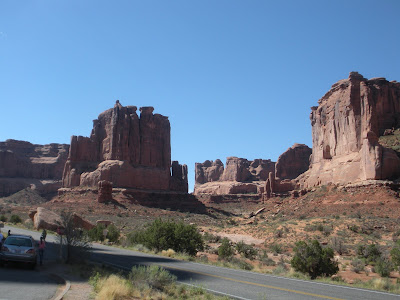
Arches and the town of Moab are among my favorite places. This was first prompted by Edward Abbey's seminal book Desert Solitaire, which I read many years ago. Abbey worked for several seasons as a ranger at Arches back during the late 50s, I believe, when it was much less developed than it is today. Although he was from Pennsylvania (very close to Tracey's hometown), he grew to love the west, especially its geography and geology. A reading of Desert Solitaire is an education in the desert west and southwest, its flora and fauna, its geological history, and its possible destruction due to improper use.
 I've been to Moab several times before and wish I could have stayed longer this time. But two short forays into Arches were a reminder of the dramatic landscape and formations to be found there. Everyone has probably seen, at least in photographs, Delicate Arch, the natural formation that has become Utah's symbol. (This is a photo of a photo of the arch.) It's a fairly lengthy hike out to Delicate Arch, and I didn't have the time on this visit.
I've been to Moab several times before and wish I could have stayed longer this time. But two short forays into Arches were a reminder of the dramatic landscape and formations to be found there. Everyone has probably seen, at least in photographs, Delicate Arch, the natural formation that has become Utah's symbol. (This is a photo of a photo of the arch.) It's a fairly lengthy hike out to Delicate Arch, and I didn't have the time on this visit. I focused instead on two other notable features of Arches: Park Avenue and Balanced Rock. Park Avenue is so named because you can walk in a valley between two gigantic parallel rock walls whose formations are reminicient of New York skyscrapers.

I got to Park Avenue just after dusk, so my photos are fairly dark. But Park Avenue is a great place to sit and contemplate while the sun goes down and changes the colors on the towering walls. You get to see various hues of dusky reds and golds as the light fades.
Balanced Rock is just a phenomenon. Who knows how long this gargantuan bolder has been perched on its pedestal. This 128-foot formation is the result of millions of years of wind, water, and ice wedge erosion. You can see the various types of rock layers that eroded differently over the eons. Some day the inevitable will happen -- Balanced Rock will topple from its perch.



No comments:
Post a Comment